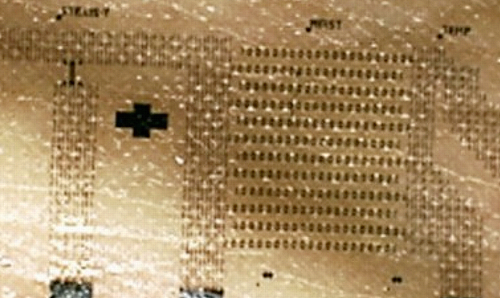
CAMBRIDGE, Massachusetts, August 19, 2022 (ENS) – Engineers at the Massachusetts Institute of Technology, MIT, have devised a new kind of wearable sensor that communicates wirelessly without onboard chips or batteries.
The team’s sensor design is a form of electronic skin, or “e-skin,” a flexible, semiconducting film that conforms to the skin like electronic Scotch tape.
Their design, detailed in the August 18 issue of the journal “Science,” opens a path toward chip-free wireless sensors.
Wearable sensors are everywhere today with wireless technology that enables a person’s physical state – glucose concentrations, blood pressure, heart rate, temperature, oxygen saturation, and activity levels to be transmitted from sensor to smartphone for analysis.
Today’s wearable sensor-based health monitoring systems have flexible sensors that can be integrated into textiles, clothes, and wrist bands or directly attached to the body. In addition, wearable micro-electro-mechanical system motion sensors such as accelerometers, gyroscopes, and magnetic field sensors are widely used for measuring activity signals.
Continuous monitoring of physiological signals can facilitate early detection and diagnosis of heart, nerve and lung diseases. Real-time monitoring helps in fall detection, gait pattern and posture analysis, and in sleep assessment.
Most wireless sensors communicate via embedded Bluetooth chips that are themselves powered by small batteries. But these conventional chips and power sources will likely be too bulky for next-generation sensors, which are taking on smaller, thinner, more flexible forms.
The heart of the new MIT wearable sensor is a nano-thin, high-quality film of gallium nitride, a material that is known for its piezoelectric properties, meaning that it can both produce an electrical signal in response to mechanical strain and mechanically vibrate in response to an electrical impulse.
The researchers found they could harness gallium nitride’s two-way piezoelectric properties and use the material for both sensing and wireless communication simultaneously.

“If there is any change in the pulse, or chemicals in sweat, or even ultraviolet exposure to skin, all of this activity can change the pattern of surface acoustic waves on the gallium nitride film. And the sensitivity of our film is so high that it can detect these changes,” observes first author and former MIT postdoc Yeongin Kim, who is now an assistant professor at the University of Cincinnati.
To test their idea, the researchers produced a thin film of pure, high-quality gallium nitride and paired it with a conducting layer of gold to boost any incoming or outgoing electrical signal.
They deposited the gold in the pattern of repeating dumbbells – a lattice-like configuration that gave flexibility to the normally rigid metal. The gallium nitride and gold, which they consider to be a sample of electronic skin, measures just 250 nanometers thick – about 100 times thinner than the width of a human hair.
The research team showed that the device was sensitive enough to vibrate in response to a person’s heartbeat, as well as the salt in their sweat, and that the material’s vibrations generated an electrical signal that could be read by a nearby receiver.
In this way, the device was able to wirelessly transmit sensing information without a chip or battery.
“Chips require a lot of power, but our device could make a system very light without having any chips that are power-hungry,” says the study’s corresponding author, Jeehwan Kim, an associate professor of mechanical engineering and of materials science and engineering, and a principal investigator in the MIT Research Laboratory of Electronics.
“You could put it on your body like a bandage, and, paired with a wireless reader on your cellphone, you could wirelessly monitor your pulse, sweat, and other biological signals,” Jeehwan Kim explained.

The scientists placed the new e-skin on volunteers’ wrists and necks and used a simple antenna, held nearby, to wirelessly register the device’s frequency without physically contacting the sensor itself. The device was able to sense and wirelessly transmit changes in the surface acoustic waves of the gallium nitride on volunteers’ skin related to their heart rate.
The team also paired the e-skin with a thin ion-sensing membrane – a material that selectively attracts a target ion, and in this case, sodium. With this enhancement, the device could sense and wireless transmit changing sodium levels as a volunteer held onto a heat pad and began to sweat.
The researchers see their results as a first step toward chip-free wireless sensors, and they envision that the current e-skin device could be paired with other selective membranes to monitor other vital biomarkers.
“We showed sodium sensing, but if you change the sensing membrane, you could detect any target biomarker, such as glucose, or cortisol related to stress levels,” says co-author and MIT postdoc Jun Min Suh. “It’s quite a versatile platform.”
Kim’s co-authors include co-corresponding author Jiyeon Han of the luxury Korean cosmetics company AMORE PACIFIC, which helped motivate and financially support the current work; members of the Kim Research Group at MIT; and other collaborators at the University of Virginia, Washington University in St. Louis, and several institutions across South Korea.
Featured image: Electronic skin made at the MIT Research Laboratory of Electronics. 2022 (Photo courtesy the researchers)



